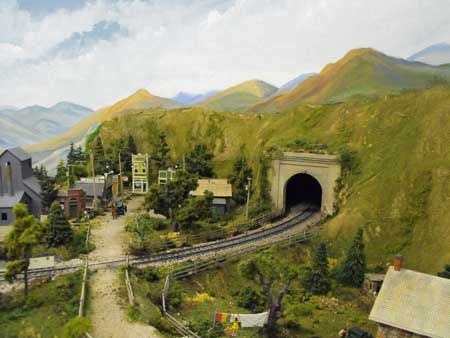Building Techniques
Micro vs N Scale Model Railroads: Understanding Scale Comparison, Gauge Differences, and Layout Sizes

Introduction to Model Railroad Scales
We often hear enthusiasts discussing the intricate world of model railroading, where every detail counts and the scale is a critical aspect of the hobby. In this realm, the terms ‘micro-scale’ and ‘N scale’ frequently come up. But what exactly sets these two scales apart? For both novice and seasoned collectors, understanding the difference between micro-scale model railroads and N scale is vital in creating a satisfying miniature railroading experience.
Defining Micro-Scale and N Scale
Before we delve into the distinctions, let’s define what we mean by ‘micro-scale’ and ‘N scale’. The term ‘micro-scale’ generally refers to model trains that are smaller than the more common scales, including a variety of scales like Z scale, which is one of the smallest commercially available. On the other hand, N scale is a specific model train scale, sized at 1:160, meaning one foot on the N scale model equates to 160 feet in the real world.
The Significance of Scale Comparison
Scale comparison is crucial since it determines how much space you’ll need for your layout and how realistic your model railroad will look. N scale trains are a popular choice for hobbyists who want a balance between detail and space efficiency. In contrast, micro-scale trains, such as those in Z scale, are often favored for their ability to fit elaborate scenes into a very compact area, making them ideal for those with limited space.
Gauge Difference: A Key Factor
Gauge difference is another key factor that differentiates various model train scales. The gauge is the distance between the rails on the track. For N scale, the standard gauge is 9 mm, which is designed to represent standard gauge tracks in the real world. Micro-scale model railroads, particularly Z scale, have an even narrower gauge of 6.5 mm, which further reduces the size of the layout.
Layout Size: Planning Your Space
When planning a model railroad, layout size is a significant consideration. N scale layouts can range from small tabletop setups to vast basement-spanning creations. Micro-scale layouts, given their smaller size, can be more versatile in terms of placement, with some enthusiasts even incorporating them into coffee tables or small dioramas.
Miniature Railroading: A World of Detail
Miniature railroading is all about the detail and authenticity that can be packed into a small space. Both N scale and micro-scale model railroads offer an impressive level of detail, with manufacturers continually pushing the limits of how much can be included in these tiny replicas. However, due to the smaller size of micro-scale models, there might be some trade-offs in terms of the fineness of detail compared to N scale.
The Charm of Z Scale
Z scale, the most popular of the micro-scales, holds a special place in the hearts of many hobbyists. Despite its diminutive size, Z scale offers a high degree of precision and quality, with many trains and accessories available for creating intricate layouts. Its small size can be particularly appealing to those looking to create detailed scenes where space is at a premium.
Choosing Between Micro and N Scale
Choosing between micro and N scale ultimately depends on your personal preferences, space availability, and what you hope to achieve with your model railroad. N scale offers a great mix of detail and manageable size, while micro-scale, especially Z scale, is perfect for those looking to create an impressive railroad in a minimal space.
Conclusion
In the end, whether you choose micro-scale or N scale model railroads, both scales have their unique advantages and can provide endless hours of enjoyment. The key is to consider the space you have available, the level of detail you desire, and how much time and resources you’re willing to invest in your miniature world. With careful planning and a bit of creativity, you can build a model railroad that not only meets but exceeds your expectations, no matter the scale.

Hi there! I’m Timothy Robinson, a 51-year-old male living in Denver, CO, US. As a News Editor for NewsRoomFeed.com, I bring you the latest and most accurate news stories daily. With my degree from UNT, I’ve honed my skills in journalism and storytelling to deliver informative and engaging content to our readers.
But I’m not just all work and no play. Outside of my career, I have diverse interests and hobbies that bring joy and balance to my life. One of my passions is building custom model trains. I spend countless hours in my garage, immersing myself in the creative process of assembling and detailing the intricate train engines. I also construct scale tracks that accurately represent real-world railway systems, complete with miniatures of American Home Town railroad depots and authentic-looking woodland scenery.
You’ll often find me exploring the breathtaking mountains and trails around Denver when I’m not in my garage. Hiking is my way of finding solace in the great outdoors, where I can embrace nature’s serenity and tranquility. From conquering challenging summits to enjoying a leisurely stroll, hiking provides me with the perfect blend of physical activity and mental rejuvenation.
But above all, I value spending quality time with my family. We bond over game nights, embark on exciting road trips, and savor delicious home-cooked meals together. These moments of connection and love create cherished memories that will last a lifetime.
Through my passion for model trains, love for hiking, and devotion to family, I lead a well-rounded and fulfilling life outside my role as a dedicated News Editor. Stay tuned for more as I explore the news world and share my adventures.





